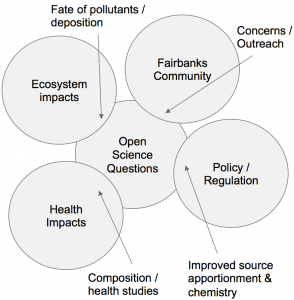The ALPACA project seeks to resolve open science questions regarding wintertime low-photochemical pollutant processing. These questions arise from community concerns and answers to the questions can improve community understanding, improve policy, health, and understanding of ecosystem impacts. The figure below shows the coupled aspects of this study. 
The workshop will identify and refine the most critical open questions regarding dark wintertime boundary-layer urban air pollution and design a field study to address them. Our starting questions are:
-
- What is the role of secondary chemistry in increasing fine particulate pollution under cold and dark conditions?
- How is sulfur oxidized under these conditions?
- Do cold conditions and particle-phase chemistry produce non-traditional SOA?
- What is the role of aerosol acidity and phase on secondary processes?
- What are the key wintertime emission sources, and how do these emissions impact processing of pollution?
- How does boundary layer meteorology play a role in wintertime urban air pollution?
- How does lack of mixing of background, ozone-rich, air with urban polluted air affect the urban and downwind pollutant transformation and deposition?
- How can this science improve air quality?
- How can we use the knowledge gained to improve regional modeling for better predictions of urban air quality and therefore design of wintertime air pollution mitigation strategies for urban areas?
- Can we use the findings in community outreach activities to improve local understanding of pollution sources?
- What are the ecosystem impacts of pollution from Northern cities?
- What is the role of secondary chemistry in increasing fine particulate pollution under cold and dark conditions?
